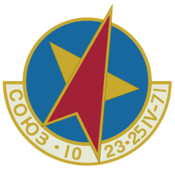| Mission type | Dock with Salyut 1 |
|---|---|
| Operator | Soviet space program |
| COSPAR ID | 1971-034A |
| SATCAT no. | 05172 |
| Mission duration | 1 day 23 hours 45 minutes 54 seconds |
| Orbits completed | 32 |
| Spacecraft properties | |
| Spacecraft | Soyuz 7K-T No. 31[1] |
| Spacecraft type | Soyuz 7K-OKS |
| Manufacturer | Experimental Design Bureau (OKB-1) |
| Launch mass | 6525 kg [2] |
| Landing mass | 1200 kg |
| Crew | |
| Crew size | 3 |
| Members | Vladimir Shatalov Aleksei Yeliseyev Nikolai Rukavishnikov |
| Callsign | Гранит (Granit - "Granite") [3] |
| Start of mission | |
| Launch date | 22 April 1971, 23:54:06 GMT |
| Rocket | Soyuz |
| Launch site | Baikonur, Site 1/5[4] |
| End of mission | |
| Landing date | 24 April 1971, 23:40:00 GMT |
| Landing site | 120 km northeast of Karaganda, Kazakhstan |
| Orbital parameters | |
| Reference system | Geocentric orbit[5] |
| Regime | Low Earth orbit |
| Perigee altitude | 208.0 km |
| Apogee altitude | 246.0 km |
| Inclination | 51.6° |
| Period | 89.0 minutes |
 Soyuz 10 mission patch | |
Soyuz 10 (Russian: 'Союз 10', Union 10) was launched on 22 April 1971 as the world's first mission to the world's first space station, the Soviet Salyut 1. The docking was not successful and the crew, Vladimir Shatalov, Aleksei Yeliseyev, and Nikolai Rukavishnikov, returned to Earth without having entered the station. Following difficulties in docking pairs of Soyuz capsules, this would be the first of numerous docking failures in the Soviet space station program.[6]
